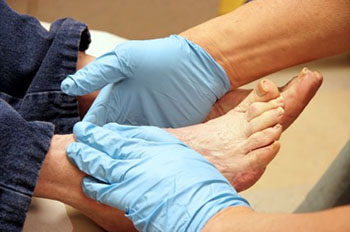
If you have any general questions that you would like answered, please visit our Facebook page and message us with your questions, we will try to answer all questions submitted.
DISCLAIMER - We can not give any direct individual medical advice on our website or social media pages.
What is a Diabetic Foot Ulcer? - Any break in the skin of a diabetic patient can be considered an ulcer, even a cut, scrape, or blister, however usually the context of an ulcer means that there is a sore or break in the skin that is deeper than a usual cut/scrape.
Do diabetic shoes really help? - YES! There have been many studies done that show that reducing pressure and irritation on the feet with diabetic shoes and insoles can help prevent foot problems, especially ulcers.
What are diabetic shoes and insoles? - Diabetic shoes are shoes that have been evaluated specifically to show they are of a certain standard for support, structure, and durability. A diabetic shoe must be extra-depth as well. Diabetic inserts must be made out of specific 3 layers of material. These materials have shown that they help support the foot while reducing pressure and friction on the foot, which can lead to irritation and sores.
Do I need the diabetic insoles with the shoes? - It is required by some insurance companies (Medicare plans specifically) to dispense both shoes and insoles at the same time in order to obtain the maximum benefit from the shoes and insoles. Also, many of the diabetic shoes do not come with insoles of their own like shoes you buy at the store, so it is necessary to get separate insoles for the shoes.
Will Medicare pay for diabetic shoes? - As long as you meet certain specifications, yes, Medicare plans cover the shoes (most plans at 80% like all other medical care). Diabetic shoes and insoles are also a covered benefit on many commercial insurance plans. Keep in mind that just like all other medical care, the shoes/insoles are subject to any deductibles.
Where do I buy diabetic shoes? - In order for your insurance to pay for the shoes, they must be prescribed by a physician. Some doctors’ offices will fit and dispense shoes from their office (like Brondon Foot and Ankle!). Other times, physicians with send a patient to an orthotist.
How does a diabetic ulcer form? - All ulcers come from repetitive pressure and friction to an area over time. Sometimes a callus can form in an area as a precursor to an ulcer showing there is excess pressure to the site. Other times, a blister may form first. If the pressure is not removed from the area, the irritation and pressure continue to rub at the area and the skin can break down into an ulcer.
What can I do to prevent diabetic ulcers? - The most important way to prevent ulcers is to be observant of your feet. Check them daily! Look for signs of pressure and rubbing, such as calluses, red spots, blisters, etc. Also, make sure you are wearing shoes that fit correctly and limit barefoot walking, especially if you have neuropathy. If you notice something that doesn’t look right, call your podiatrist as soon as possible for an appointment.
When should I get an diabetic ulcer looked at by a podiatrist? - As soon as possible! With diabetics, ulcers can go from bad to worse very quickly.
How should a diabetic ulcer be treated? - The first step to treatment is to remove whatever irritant caused the pressure and rubbing in the first place. Wound care is also important. Keeping a wound clean and applying antibiotic and and a bandage can go a long way, especially if the ulcer is not deep. If the ulcer is infected, antibiotics may be needed. If basic wound care is not working, more specialized wound care may also be necessary.
